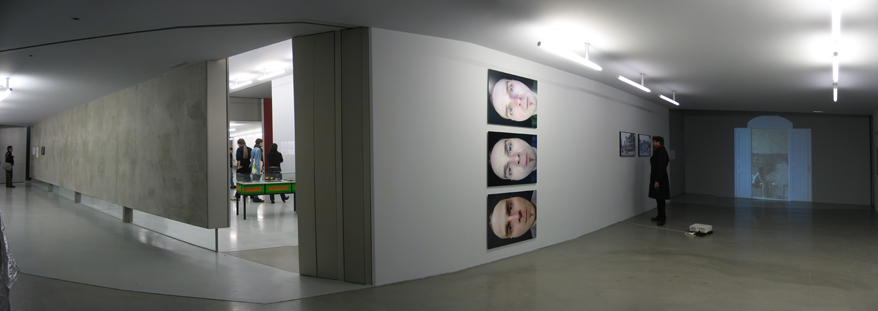This is the text of my keynote speech at the conference Thinking Europe – Discourses and Models that was organized within the Scenarios about Europe: Scenario 3 exhibition at Galerie für Zeitgenössische Kunst in Leipzig, 28 January 2012. The exhibition featued a[4]. The book Thinking Europe: The Scenario-Book was presented at the Europe hoch n festival in the House of World Cultures in Berlin. (Amazon).

a[4], exhibition view, Scenarios about Europe: Scenario 3, Galerie für Zeitgenössische Kunst, Leipzig.
Taking the concept of the Scenarios project, perhaps we could address the possibilities, functions and roles of art through a set of scenarios. Compared to the conventional ones, these scenarios are open and unpredictable, in the constant process of rewriting and remodeling. Therefore, I would be careful towards fixed and coherent platforms in viewing contemporary art, and in this intro I offer fragments of my personal thoughts.
In response to the key topics of the panel, I think that art is not fundamentally dysfunctional, and that it has some impact on politics and economy. The questions such as ‘what is the role of art?’, ‘what is the significance and sense of art?’ express the challenges that artists face continuously (although maybe more frequently when they are young or new to art and more seldom as they age), often and in various ways observing that art defines itself. This may be valid on some conceptual and production levels but, since art is a biological luxury, its identity and its social position are significantly influenced (if not determined) by the broader economic and political circumstances of the world.
I entered art career in a quest of introspection and self-questioning, and my work is motivated by the need for transformation and overcoming the personal restraints through creative process. The most exciting aspect of art-making for me is the research and especially the change that it induces on a physiological, cognitive and emotional plan. It is reflected in the artist’s theoretical, procedural and technical approach, and its momentum is abstracted and encoded in the artwork, thus becoming accessible to the public. These two modes of change – the change of the artist and the possible change of the observer – constitute a kind of nano-ecology or nano-politics with certain, more or less significant, environmental consequences.
I believe that art should always question and interrogate the relevant aspects of human experience, perception, relations and notions, and offer that questioning to the public in an intelligent, comprehensive and unpretentious way. In the complex relational system of economy, politics, culture and art,[1] individual artists can operate on a relatively small scale and with relatively limited outcomes, but should give it their very best. This requires openness and flexibility, but also brings up the issue of the artists’ ethical maturity vis-à-vis the infamously corruptive strategies of competition in culture and society.
In a highly diversified cultural sector during the last two decades (not just with current economic crisis), the social skills and social networking in art, the entrepreneurial execution and systematic presentation of art and became paradigmatic, while at the same time the perspectives for individual artists and the effectiveness of art became somewhat diminished and discouraging.[2] Proper investigation of this trend would require a special symposium and we can address it only partially in our panel discussion.
However the trend is real and certainly, as Jasper Johns once noted, we could imagine a society without any art at all. But today, it would include a wide spectrum of global scenarios, from the one in which art is just a brand category of a completely homogenized consumerist culture, to the one in which human creativity had evolved into a fusion of scientific, technological and artistic mentality. With some trust in the potentials of human mind and human nature, it will be particularly interesting to view these scenarios in the probably not so distant age of pervasive biotechnological, genetic and neural modifications.
Life itself is always far more interesting than art (or any other isolated field of human experience), but for both the artist and for the society art functions as a refreshing reminder to that simple insight. It manifests our specifically human need to overcome our biological circumstances. As neuroscientist Vilayanur S. Ramachandran remarks, quoting Thomas Henry Huxley:
We are not angels, we are merely sophisticated apes. Yet, we feel like angels trapped inside the bodies of beasts, craving transcendence and all the time trying to spread our wings and fly off, and it’s really a very odd predicament to be in, if you think about it.[3]
-
Manuel Castells, The Rise of the Network Society (The Information Age Vol. 1), Wiley-Blackwell, 2010. ↩
-
Julian Stallabrass, Contemporary Art: A Very Short Introduction, Oxford University Press, 2006. ↩
-
Vilayanur S. Ramachandran, Purple Numbers and Sharp Cheese in The Emerging Mind, Reith Lectures, BBC, 2003. ↩